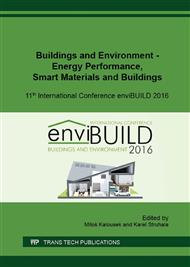p.112
p.120
p.129
p.137
p.141
p.151
p.160
p.167
p.175
The Effect of Aggregate Type on the Properties of Lime Mortars
Abstract:
Lime mortars represent indispensable building materials that have been used for centuries in civil engineering. Considering the necessity of numerous restoration work on historical buildings, a research of the applicability and suitability of various types of plasters for repairing the historical plasters has been developed. This work presents the applicability of limestone aggregate and limestone fines to aerial lime-based mortars. The role of aggregates on the properties of lime mortars is examined in this paper by comparing pure quartz sand and limestone aggregate and its quantity in the mortar. It was found that limestone aggregate produced the comparable or higher mortar strengths than quartz aggregate and slightly increased porosity, water absorptive capacity and carbonation rate of the mortars. Partially replacement of aggregate by limestone fines has caused dramatic growth in strength, especially in mortars with high content of binder. The applied limestone aggregate is convenient to lime-based mortars and the addition of limestone fines contributes to better mechanical properties of lime mortars.
Info:
Periodical:
Pages:
141-148
Citation:
Online since:
December 2016
Authors:
Keywords:
Price:
Сopyright:
© 2017 Trans Tech Publications Ltd. All Rights Reserved
Share:
Citation:


